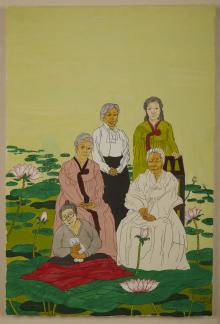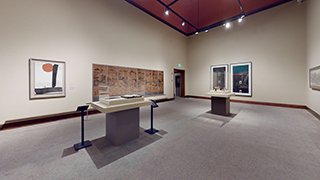Back
Capital and Countryside in Korea
YUN Suknam 윤석남 (b. 1939). Korean, Republican period, 2018. We are a Matrilineal Family. Framed painting; ink and color pigment on hanji (Korean mulberry paper), 26 x 18 ⅛ in. Farwest Steel Korean Art Endowment Fund Purchase. 2018:35.1
LEE Sang-beom 이상범 (1897-1972). Korean; Republican period, circa 1963. Autumn. Framed painting; ink and color on paper, 23 x 63 in. Gift of the Georgia-Pacific Corporation, Portland. 1981:1
Capital and Countryside in Korea
June 03, 2023 to May 19, 2024
Opening in June 2023 in the Jin Joo Gallery of the Wan Koo and Young Ja Huh Korean Art Wing, Capital and Countryside in Korea will investigate the representation of urban and rural spaces in Korean art. Touching upon themes of memory and nostalgia, cultural heritage, written language, production and industry, and the significance of specific locales, this exhibition examines how these spaces have impacted the histories, cultures, and identities of people throughout the Korean Peninsula. A variety of works spanning the Three Kingdoms period (57 BCE-668 CE) through the present will be featured, including a Joseon-period (1392-1897) manuscript book of maps, a four-part print portfolio by the groundbreaking video artist PAIK Nam June (1932-2006), a monumental North Korean landscape painting by SEONU Yeong (1946-2009), and on display for the first time at the JSMA, an eight-panel folding screen showcasing important views of Jeju Island.
Click the image to explore the virtual tour:
In conversation with the objects on view in Capital and Countryside in Korea, the Huh Wing Gallery will feature a selection of works by modern and contemporary women artists in celebration of the 50th anniversary of the University of Oregon’s Center for the Study of Women in Society (CSWS). These works recall the painting traditions of the yangban—the male Neo-Confucian scholar-officials who governed during the Joseon period. Joseon Korea was one of the most gendered societies of its time. Politics, scholarship, and the arts were all dominated by men, and women of the yangban class were almost exclusively confined to the domestic sphere; their contributions often overlooked and obscured. By evoking yangban artistic traditions like literati landscape paintings, Ten Symbols of Longevity pictures (shipjangsaeng-do), ancestor portraits, and scholarly-accoutrement images (chaekgeori-do), these 20th-21st century women artists claim these cultural traditions as their own and highlight the important contributions made by Korean women.
Both installations are curated by MacKenzie Coyle, Post-Graduate Curatorial Fellow in Asian Art, and will be on view through May 2024.








